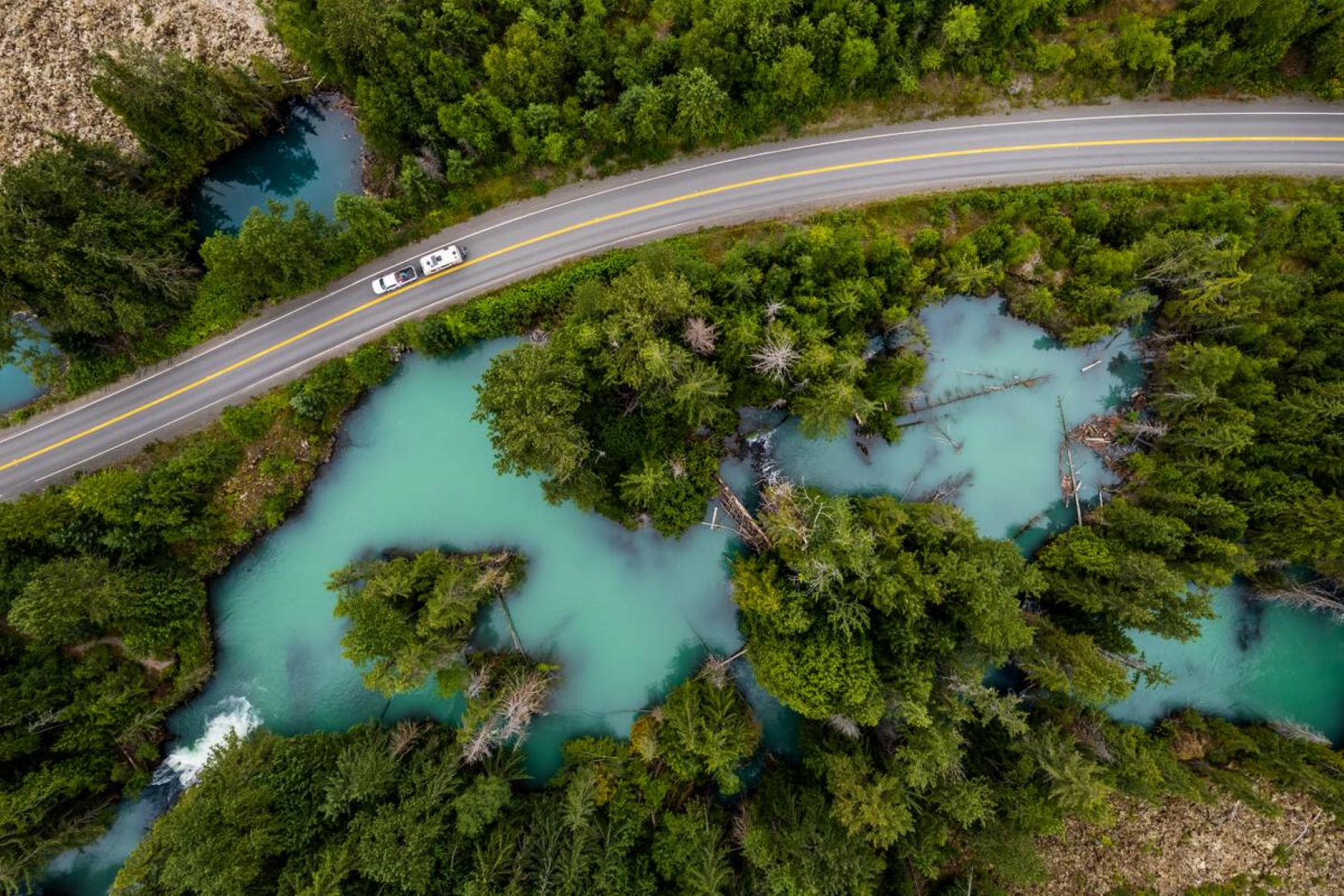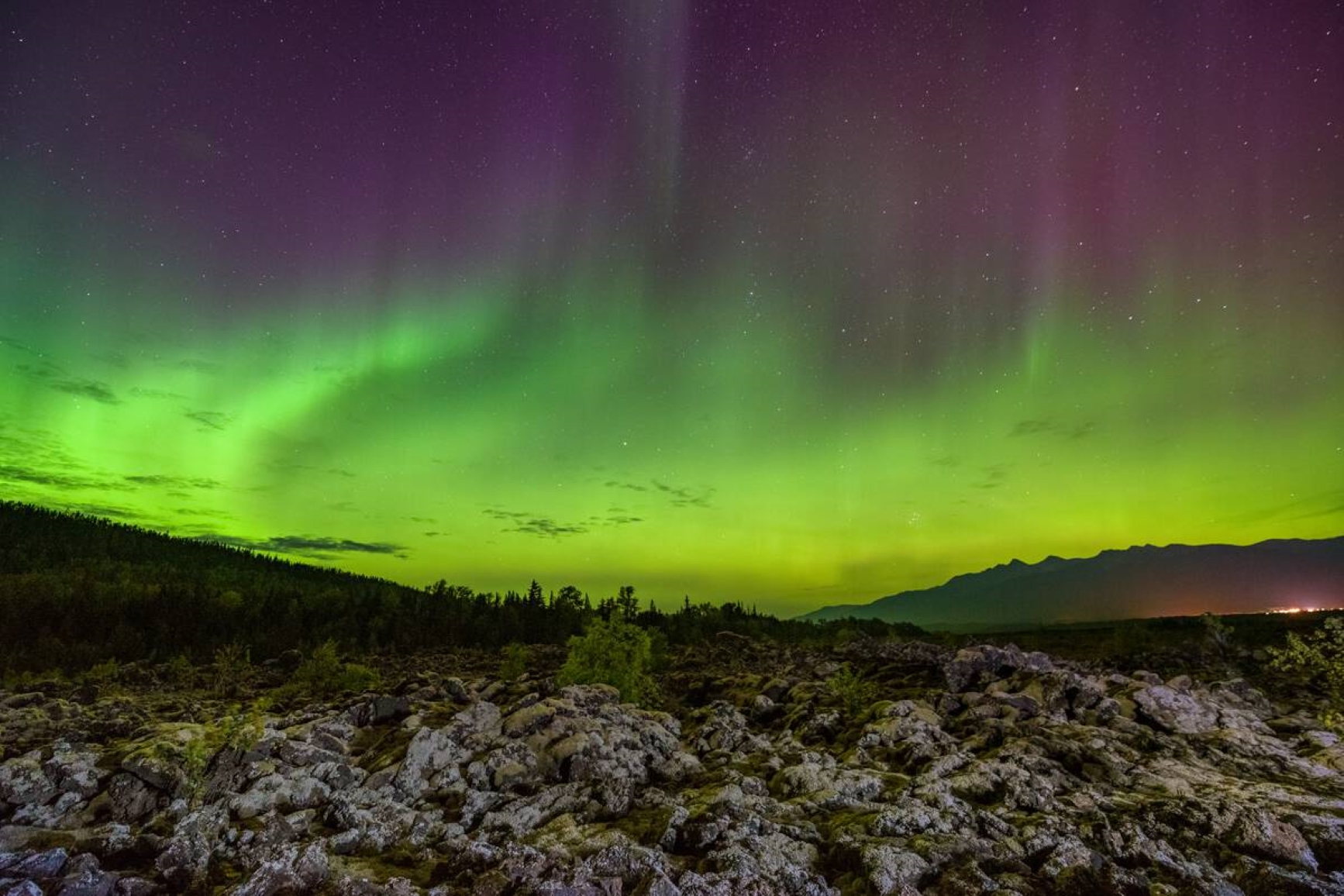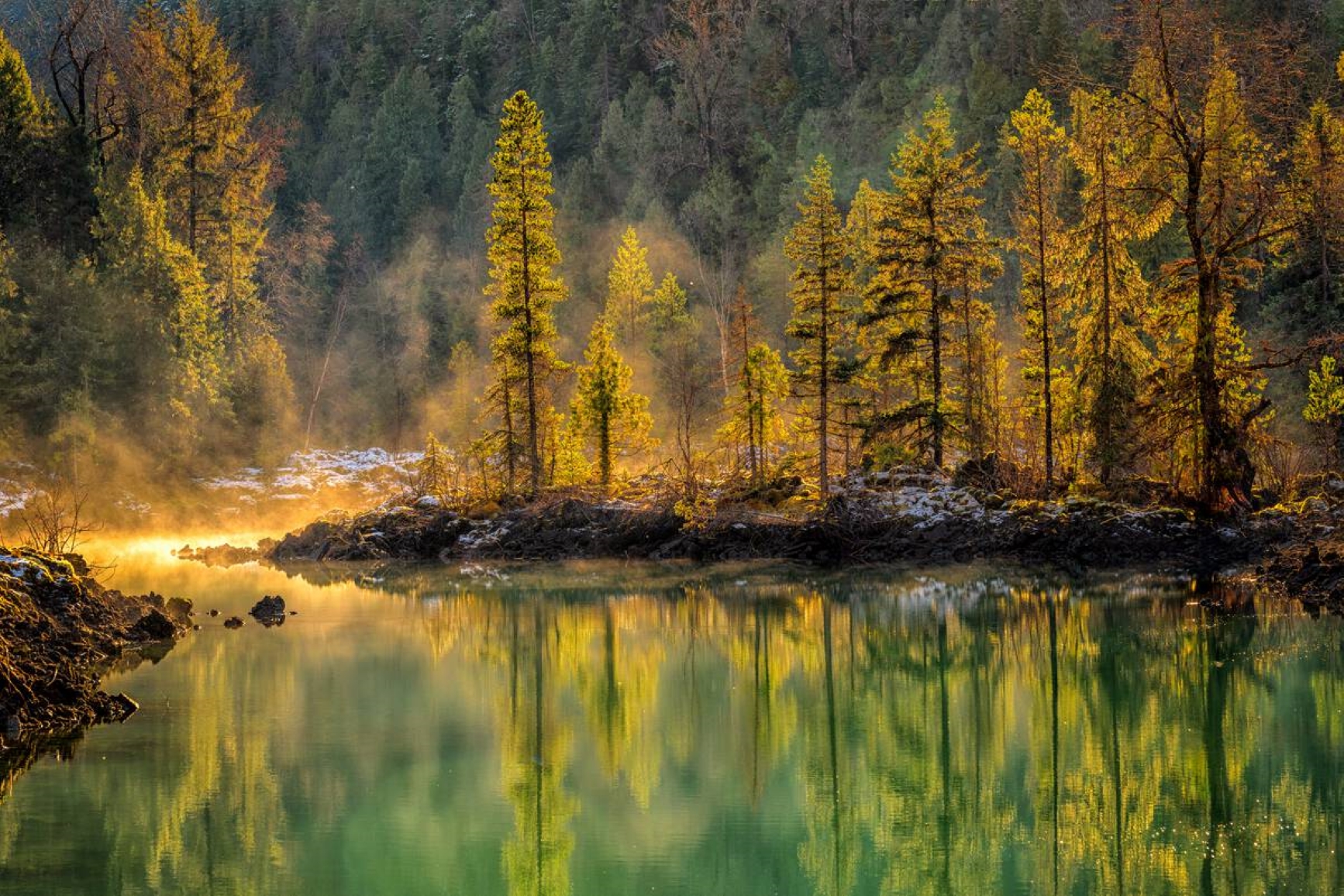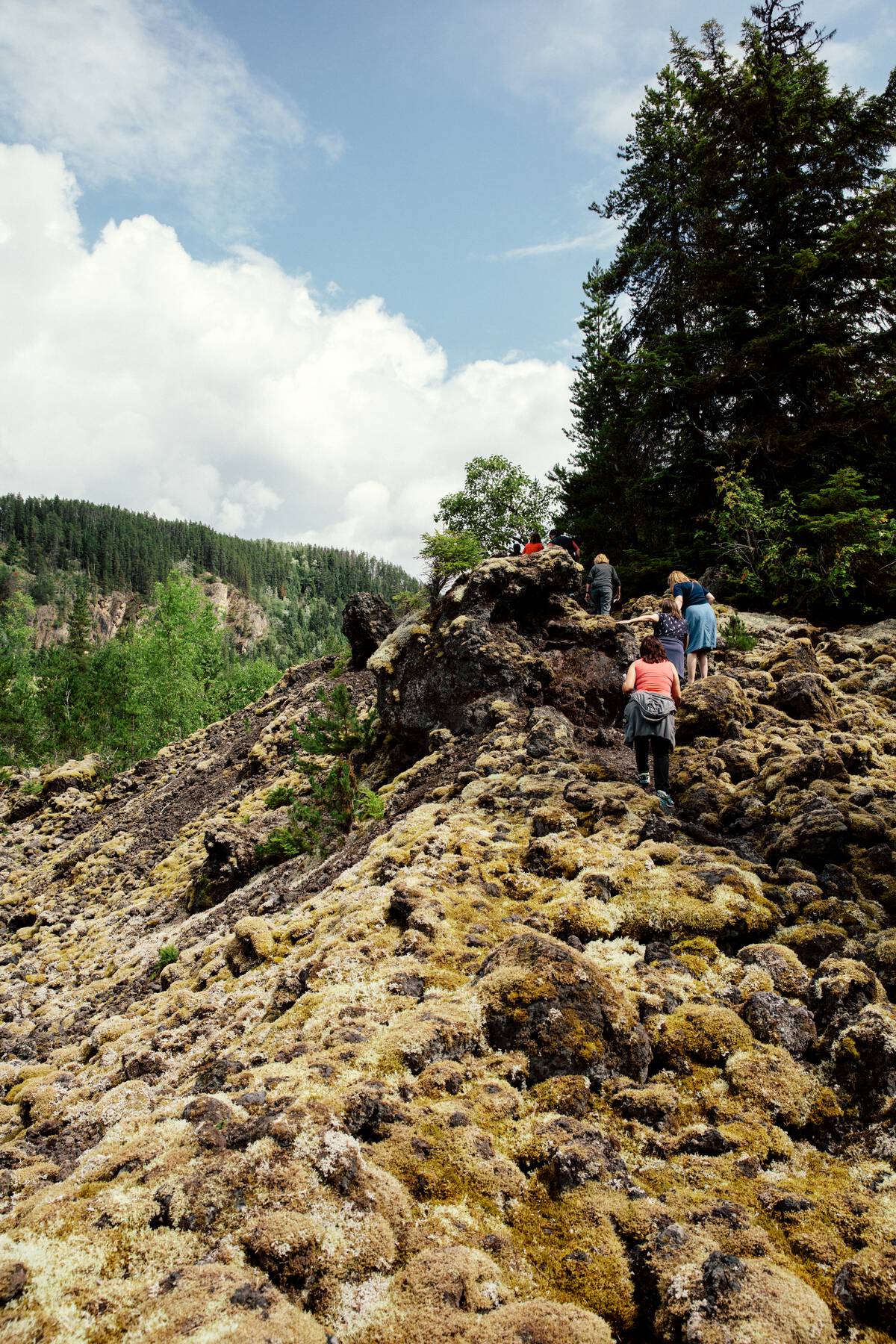Park overview
The dramatic volcanic landscape blended with rich First Nations culture makes this park a special experience. The Nisg̱a’a alkali basalt flow is one of the youngest and most accessible volcanic features in British Columbia. Guided tours let you explore old growth forests, view the volcanic crater, and learn about the culture and legends of the Nisg̱a’a people.
This park is part of the landmark treaty, the Nisg̱a’a Final Agreement, between the Government of Canada and the Nisg̱a’a Nation. It was the first provincial park in BC established to combine interpretation of natural features and First Nations culture. It was the first park to be jointly managed by a First Nation and BC Parks.
Advisories
Dates of operation
The park is open May 15, 2024 to September 15, 2024
- Facility type
- Frontcountry camping
- Number of campsites
- Vehicle-accessible sites: 16
- Main operating season
- 2024: May 15 to September 15
- Winter season
- No services
Safety info
Explore with care as lava rock may be sharp and unstable, and surfaces may be thin, especially along lake and stream edges.
Special notes
Mushroom harvesting is not permitted within the park. Check with Nisg̱a’a Lisims Government for licensing requirements for harvesting mushrooms on Nisg̱a’a Lands.
The Lava Cone is accessible by guided tour only. See the hiking section for details.
Camping
Vetter Creek
The campground offers 16 vehicle-accessible campsites on a first come, first served basis. Campsite reservations are not accepted.
Large sites for RVs, double sites, and wheelchair-accessible sites are available. Most sites are shaded by the surrounding deciduous forest. Additional parking is available at the Nisga’a Visitor Centre next to the campground. Self-registration, running water, and firewood are available. There are no sani-dump facilities.
For a park map, see park and activity maps.
Fees
| Vehicle-accessible camping fee (per night) | $20 per party |
| BC seniors’ rate (per night from the day after Labour Day to June 14 only) | $10 per senior party |
To learn more about the BC Senior Camping Discount, see the camping fees page.
Wilderness camping is permitted in the backcountry and alpine areas, but there are no developed trails to access these areas. Wilderness camping is not permitted on the lava beds or in the frontcountry.
For a park map, see park and activity maps.
Facilities
Accessibility information is available for these areas of the park:
There is a groundwater hand pump at the campground. The water is tested monthly, but is under a permanent boil water advisory.
To access the Nass River, a single lane, gravel boat launch can be found at the park’s north end. Overnight moorage is not recommended here due to fluctuating river levels.
To access Lava Lake, a single lane, gravel boat launch can be found at the park’s south end.
Parking space is available for vehicle and boat trailers at both locations.
For boat launch locations, see park and activity maps.
We encourage visitors to conserve wood and use camp stoves instead of fires. Fire rings are available at the Lava Lake day use area, the visitor centre, and at each campsite. Firewood is available to purchase at the campground.
Campfires are allowed in the backcountry. However, you should always follow Leave No Trace outdoor ethics. Campfires are prohibited on the lava beds.
To preserve plants and ground cover, do not gather firewood in the park. This is an offence under the Park Act. Dead wood is important habitat for plants and animals, and it adds valuable organic material to the soil.
Campfire bans may be in place. Before lighting a fire, check for bans or restrictions on BC Wildfire Service and on local or Indigenous government websites.
Nisg̱a’a Visitor Centre
The Nisga’a Visitor Centre is located at the campground and offers merchandise, maps, stories, pictures, and information about attractions. Learn about Nisg̱a’a language, culture, history, feasts, and laws.
Hours of operation:
| May 15 to June 29 | Friday, Saturday, Sunday 10 am to 5pm |
|---|---|
| June 30 to August 31 | Tuesday, Wednesday, Thursday 10 am to 5 pm Friday, Saturday, Sunday 10 am to 6 pm Closed Monday |
| September 1 to September 30 | Firday, Saturday, Sunday 10 am to 5 pm |
| Statutory holidays (except Labour Day) | Closed |
Hlgu Isgwit (Nass Valley or Nisg̱a’a) Hot Springs
The hot springs are not within the park boundaries. To visit, contact the Nisg̱a’a Lisims Government at 250-633-3000 or visit nisgaanation.ca.
Please be respectful when visiting. The area is a sacred place and must be treated with respect. Thank you for your cooperation.
Day-use and picnic areas are located at Vetter Falls, Lava Lake, and at the Visitor Centre. There are fire rings and picnic tables available at the Nisga’a Visitor Centre and the Lava Lake day-use area.
Pit toilets are available at Lava Lake, Vetter Falls campground, Vetter Falls trail, the Nisga’a Visitor Centre, and the Tseax River pullout.
A wheelchair-accessible pit toilet is located at Vetter Falls campground.
Activities
Lava Cone Trail
The Lava Cone is accessible by guided tour only.
Guided volcanic tours offer a chance to hike through the scenic old growth forest, and past a variety of volcanic features, to a viewpoint overlooking the crater.
Tours depart from the base of the Cone Trail access road, 1.4 km north of Lava Lake picnic site. The tour is a 6 km, 4 hr hike, and the trail is moderately difficult. There are some steep stairs. Bring sturdy footwear, water, snacks, and bug spray.
For tour dates, times, and prices, visit the Nisga’a Visitor Centre, or contact:
Nass Valley Tours
- Tours Sunday, Monday, and Thursday
- 250-641-4400
- nass113.com
K’Alii Aks Timber Corportation
- Tours Saturday, Wednesday, and Friday
- lavabedoperator@gmail.com
Self-guided trails
Five short interpretive trails provide easy access to several of the park’s special features:
- Crater Creek
- Beaupre Falls
- Tree Mould Trail
- Vetter Creek Trail
- Fish Wheel Trail
For your own safety and preservation of the park, obey posted signs and keep to designated trails. Shortcutting trails destroys plant life and soil structure.
For a trail map, see park and activity maps. Stop by the Nisga’a Visitor Centre for more information.
Some lava flow features are very delicate and need protection. Lichens cover the majority of lava flow, and a single footprint can set back hundreds of years of lichen growth. Please stay on the trails.
There is swimming available at Lava Lake. The beaches are a mixture of sand and rock.
There are no lifeguards on duty in BC Parks.
There are canoeing opportunities on Lava Lake. See the boat launch section for launching information.
There are kayaking opportunities on Lava Lake. See the boat launch section for launching information.
There are excellent fishing opportunities for salmon on the Tseax River.
Anyone fishing in British Columbia must have an appropriate licence. To learn more, see the fishing and hunting guide.
Hiking
Interpretive hiking trails and tours are available. See the hiking section for details.
Self-guided auto tour
An auto tour brochure is available on the Nisga’a Lisims Government website. Printed copies are also available at the Nisga’a Visitor Centre, the Nisg̱a’a Lisims Government Office in Gitlaxt'aamiks, and the Terrace visitor centre.
Nisga’a Visitor Centre
The Nisga’a Visitor Centre offers opportunities to learn about Nisga’a culture and the local landscape. See the information section for details.
The park is home to moose, goats, marmots, bears and many other species of wildlife.
When visiting the Vetter Falls viewpoint, visitors might get a chance to catch a glimpse of a “phantom” steelhead.
Learn more about wildlife safety.
Dogs and other domestic animals must be leashed and are not allowed in beach areas or park buildings. You must always be in control of your pets and dispose of their excrement in the wastebins provided.
Bicycles must keep to roadways. Bicycle helmets are mandatory in British Columbia.
Bicycles with electric assist motors (e-bikes) are not allowed on the trails within Nisga’a Memorial Lava Bed Corridor Protected Area. E-bikes are restricted to park roads and areas where motorized use is permitted. The only exception is for authorized and identified trail maintenance bikes conducting work on behalf of BC Parks.
Hunting is permitted within the park. Please refer to the current hunting regulations.
Nisga’a citizens must check with Nisg̱a’a Lisims Government for licensing requirements for harvesting wildlife on Nisg̱a’a Lands.
Snowmobiling is permitted in the Sterling Moutain snowmobile area. Access the area by the Sterling Mountain Parking Lot, operated by Recreation Sites and Trails BC. Most of the snowmobiling area is outside the park boundary but some portions or trail are within the park. Stay within the designated snowmobiling area marked by signs.
The easiest way to access the park is to take Highway 16 to Terrace, then north for 100 km on the Nisg̱a’a Highway. The alternate route is through Kitwanga on Highway 16. From Kitwanga, head north for 78 km on paved Highway 37 to the Cranberry River. Here the unpaved Nass Forest Service Road leads west to Gitlax̱t'aamiks (New Aiyansh), a distance of 86 km.
Just outside of the park are the four Nisg̱a’a villages of Gitlax̱t'aamiks (New Aiyansh), Ging̱olx (Kincolith), Gitwinksihlkw (Canyon City), and Lax̱g̱altsʼap (Greenville). All communities are road accessible from the park. They all offer amenities like grocery stores, bed and breakfasts, restaurants, gift shops, gas stations and health services.
Park and activity maps
Learn more about this park
Park details
- Date established: April 29, 1992
- Size: 17,717 hectares
Park contact
Nature and culture
Cultural Heritage
The history of the region is tied to legends handed down from past generations. The Nisg̱a’a house system is composed of four main families, Wolf, Raven, Killer Whale, and Eagle. Each family owns stories and passes them on to the next generation.
One of the most well-known stories is about the genesis of the volcano. Legend has it that children had shown disrespect to the life-giving salmon by putting stones and burning sticks into their backs and watching them swim. The elders warned the children repeatedly to stop but they did not listen. Soon the ground began to rumble. The volcano and the lava flow then covered the valley bottom, redirected the mighty Nass River and destroyed two villages. This resulted in 2000 Nisg̱a’a people perishing.
Conservation
This park has important volcanic features like the lava flows. As the lava spilled from the crater an estimated 250 years ago, it followed a creek bed downslope to Lava Lake and down the Tseax Valley to the Nass River. The lava travelled at different speeds depending on the steepness of the slope. Some types of lava flow and interesting features include:
Tree casts formed by burned out tree trunks leaving holes in the lava
Lava tubes formed as the top layer hardened and the lava flowed out underneath
Pahoehoe lava that often has a smooth surface or ropey form
ʻAʻā lava that is rough and jagged
Blocky lava whose surface consists of large chunks
Some lava flow features are very delicate and need protection. Lichens cover the majority of lava flow, and a single footprint can set back hundreds of years of lichen growth. Please stay on the trails.
Wildlife
If you plan on exploring the Nass Mountain Range, you will be in the company of moose, goats, marmots, bears and many other species of wildlife. Always use good judgement when in the presence of wildlife.
When visiting the Vetter Falls viewpoint, visitors might get a chance to catch a glimpse of a “phantom” steelhead.
Reconciliation with Indigenous Peoples
BC Parks honours Indigenous Peoples’ connection to the land and respects the importance of their diverse teachings, traditions, and practices within these territories. This park webpage may not adequately represent the full history of this park and the connection of Indigenous Peoples to this land. We are working in partnership with Indigenous Peoples to update our websites so that they better reflect the history and cultures of these special places.




